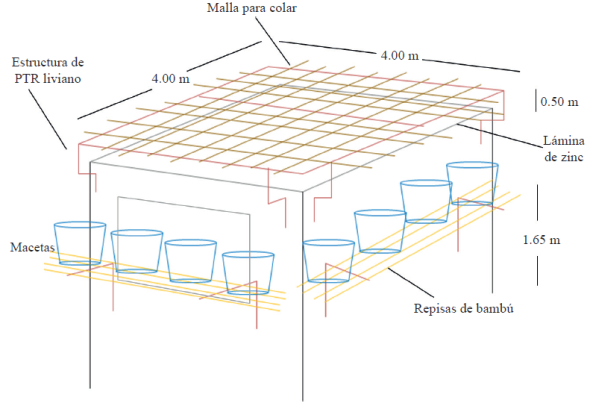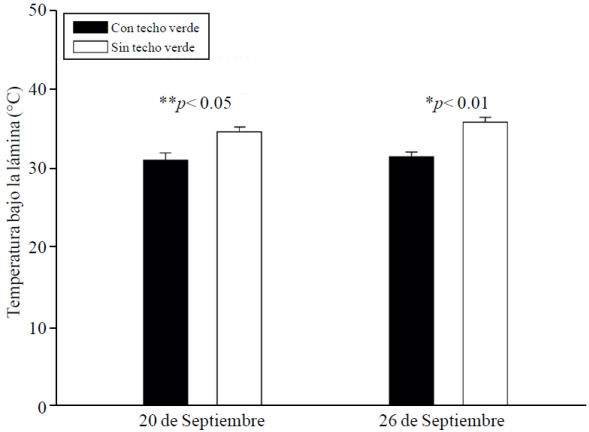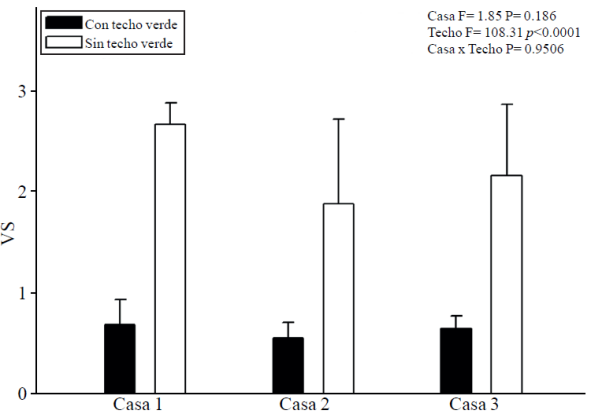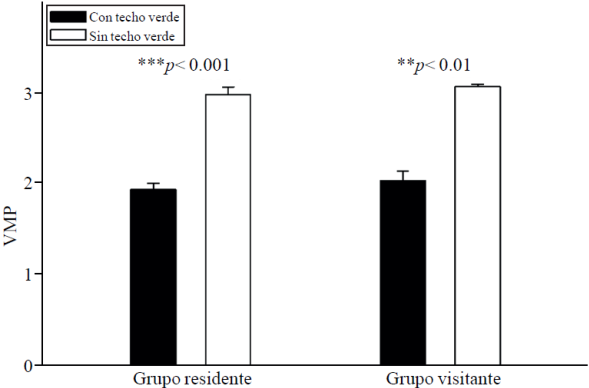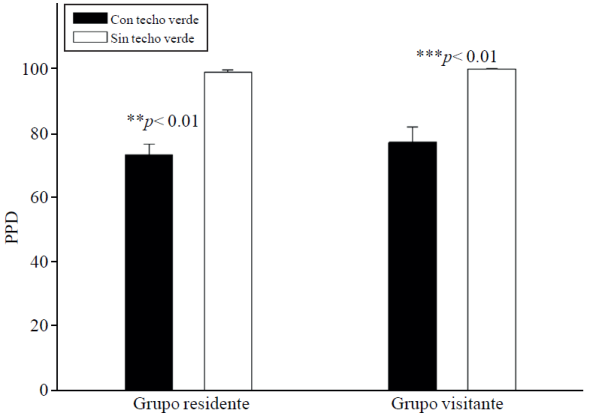Services on Demand
Journal
Article
Indicators
-
 Cited by SciELO
Cited by SciELO -
 Access statistics
Access statistics
Related links
-
 Similars in
SciELO
Similars in
SciELO
Share
Revista mexicana de ciencias agrícolas
Print version ISSN 2007-0934
Rev. Mex. Cienc. Agríc vol.5 n.spe9 Texcoco Sep./Nov. 2014
https://doi.org/10.29312/remexca.v0i9.1047
Articles
Thermal comfort of green roofs with Cissus verticillate (Vitaceae) in tropical rural dwellings
1LPI-4 Agronegocios, Agroecoturismo y Arquitectura del Paisaje, Colegio de Postgraduados Campus Veracruz, km 88.5, carretera Federal Xalapa-Veracruz. Municipio Manlio F. Altamirano, Veracruz, México. C. P. 91700. Tel: 52 (229) 2010770. Ext. 64333. (beltran.abraham@colpos.mx; parturo@colpos.mx; jcruz@colpos.com).
Green roofs have taken rise because of the several benefits they provide, including thermal mitigation of buildings, and improving thermal comfort (TC). Although it is a desirable technology in warm, tropical areas, is required to lighten its conventional design, in order to adapt it to the tropical rural dwellings. This research was conducted in Veracruz, Mexico, for evaluating the TC provided by a prototype green roof based on the use of pergolas and Creeper Cissus verticillata (Vitaceae). The temperature under the roof sheet of rural households with and without green roof was compared. The TC of the rooms was measured using subjective vote (SV), the average predicted vote (APV), and the proportion of people uncomfortable (PPU), obtained from a group of evaluators resident and another visitor, who also rated their degree acceptance of this technology. The average temperature in the room with green roof was up to 4.5 °C lower (p < 0.05) than in rooms without green roof. The SV, APV, and PPU were higher (p< 0.01, p< 0.01 and p< 0.0001, respectively) in rooms without green roof, indicating a lower TC therein. Acceptance of the visiting group was significantly higher than that of the resident (p< 0.0001). It is concluded that by using green roofs as proposed is reached greater TC in tropical rural homes.
Keywords: Cissus verticillata; average predicted vote; proportion of people uncomfortable; subjective vote
Los techos verdes han tomado auge debido a los múltiples beneficios que brindan, entre ellos la mitigación térmica de los edificios, y la mejora del confort térmico (CT). Aunque es una tecnología deseable en zonas cálidas y tropicales, se requiere aligerar su diseño convencional, a fin de adaptarlos a la vivienda rural tropical. La investigación se realizó en Veracruz, México, para evaluar el CT brindado por un prototipo de techo verde basado en el uso de pérgolas y de la enredadera Cissus verticillata (Vitaceae). Se comparó la temperatura bajo la lámina del techo de habitaciones de viviendas rurales con y sin techo verde. El CT de las habitaciones fue medido por el voto subjetivo (VS), el voto medio predicho (VMP), y la proporción de personas a disgusto (PPD), obtenidos de un grupo de evaluadores residente y otro visitante, quienes también calificaron su grado de aceptación de esta tecnología. La temperatura promedio bajo la lámina de las habitaciones con techo verde fue hasta 4.5 °C menor (p< 0.05) que en las habitaciones sin techo verde. El VS, VMP, y la PPD fueron mayores (p< 0.01, p< 0.01, y p< 0.0001, respectivamente) en las habitaciones sin techo verde, indicando un menor CT en éstas. La aceptación del grupo visitante fue significativamente mayor que la del residente (p< 0.0001). Se concluye que mediante el uso de techos verdes como el propuesto se alcanza un mayor CT en las viviendas rurales tropicales.
Palabras clave: Cissus verticillata; proporción de personas a disgusto; voto subjetivo; voto medio predicho
Introduction
Green roofs are an architectural alternative increasingly used throughout the world for its many benefits. They range from the preservation of biodiversity, mitigation of heat island effect and air pollution in urban areas, the thermal insulation of the houses that reduce caloric load and energy consumption (Berardi et al., 2014). The latter benefit takes higher importance in warm tropical areas, where the daily insolation is high most of the year (Hodo-Abalo et al., 2012).
A green roof is a structure placed on a flat or inclined surface, designed to support vegetation on a building. Typically it consists of: 1) an outer layer of vegetation; 2) a substrate layer for the support and plant nutrition; 3) a filtering membrane; 4) drainage layer; and 5) anti-root membrane, which is the layer in contact with the slab of the building (Oberndorfer et al. 2007). Passive cooling providing green roofs are mainly induced by the action of vegetation cover (Berardi et al., 2014.) it captures the most sunlight (Del Barrio, 1998; Wong et al., 2003) and minimizes heat fluctuations (Liu and Baskaran, 2003).
Of the total solar radiation reaching the topsoil, about 27% is reflected, 60% absorbed by plants and substrate, and only 13% is transmitted and absorbed by the roof of the building (Ekaterini and Dimitris, 1998; Tabares-Velasco and Srebrić, 2009). It has been determined that with the implementation of green roofs there is a decrease in the internal temperature of the housing up to 7.5 °C (Qin et al., 2012), although their effectiveness depends on the moisture content of the vegetative layer and substrate (Zinzi and Agnoli, 2012), and leaf area index of the vegetative layer (Hodo-Abalo et al., 2012).
One of the objectives of the decrease of temperature by means of green roofs is to provide better thermal comfort to people. This is defined as that condition of mind which expresses satisfaction with the thermal environment (ISO 7730, 1995). According to Kvisgaard (1997) comfort is usually measured by vote or subjective comfort votes (SV), the average predicted vote (PMV) and the percentage of people at ease (PPU). In the SV people rate their satisfaction with the ambient temperature by a thermal sensation scale of seven points, where the positive and negative ends are hot and cold, respectively, and zero represents a satisfying sensation of thermal neutrality; typically evaluated in controlled temperature chambers, wind speed and relative humidity. The APV is an objective thermal comfort index that takes into account environmental and physiological human factors, and predicts the mean value of human feeling. In their calculation, six variables are involved: metabolic rate, clothing insulation, radiant temperature and the temperature, air speed and humidity (ANSI/ASHRAE 2004). The APV PPU follows, referring to the number of people unhappy with the temperature of the site.
Most studies on green roofs and their benefits have focused on urban areas in temperate climates. However, the increase in temperature and loss of thermal comfort is not restricted to urban areas; rural areas also present problems of temperature rise inside the houses, because the patterns and processes of global warming trends are influencing current temperature (Currit and Easterling, 2009). In addition, trees and shrubs in family plots that protect houses from solar radiation are missing (Mas et al., 2004), and the type of construction has gone from homes with high ceilings light and fresh material (leaves palm, cardboard sheet, tile), a low-rise roofs with materials that absorb heat (zinc sheet and concrete), so that the implementation of green roofs can be a measure of heat mitigation. However, the heavy structure of conventional green roofs (Köhler, 2003) makes them difficult to reconcile with the characteristics of tropical rural housing; is necessary to modify the conventional design of green roofs in order to adapt to this type of housing, and evaluate the performance of the new proposal. Therefore, this study aimed to: 1) propose a prototype lightweight green roof; and 2) to evaluate, under field conditions, the thermal comfort provided under the assumption that this structure, to reduce the heat load on the roof of homes, improving thermal comfort.
Materials and methods
The research was conducted from April to September 2011 in the community of Angostillo, Paso de Ovejas, Veracruz, Mexico. The climate of the site, according to the Köppen classification modified by García (1973), Aw0"(w) (i') g, which is the driest of the warm humid climates with summer rainfall, mean annual temperature 25 °C and seasonal precipitation, with no more than 1 000 mm annual average.
Three similar houses in accordance with the following characteristics were selected:1) zinc tin roofs; 2) oriented east-west; 3) close to each other; 4) two separate rooms were available but similar dimensions and orientation; 5) whose owners would agree to modify their homes; and 6) that people commit to collaborate with plant care. The specific characteristics of the houses and rooms are described in Table 1 in each house was randomly selected a room and on this green roof prototype was built.
Table 1 Characteristics of the rooms and green roofs placed in each house.
| Casa 1 | Casa 2 | Casa 3 | |
| Tamaño de la habitación | 4 * 4 m | 3.85 * 2.15 m | 3.60 * 4 m |
| Altura del techo | 2.2 m | 2.1 m | 2.35 m |
| Núm. de macetas | 8 | 7 | 8 |
| Tipo de sostén de macetas | Dos repisas de bambú fijadas a la pared | Una repisa de bambú fijada a la pared | Dos repisas sostenidas en el suelo |
Whereas the topsoil is the main inducer of passive cooling provided by green roofs (Berardi et al., 2014) and most of the weight is due to the other layers (Köhler, 2003), the proposed prototype differs from conventional green roofs that used: 1) a pergola for growing foliage plants; 2) Container substrate for the growth of the displaced to the sides of the housing estate; and 3) Cissus verticillata (L.) Nicolson & Jarvis (Vitaceae), a native species vine plant that grows wild in the town-identified by Biol. Lorena P. Sánchez Morales, and herbarium specimens deposited in the herbarium of the Institute Biological Research of the University of Veracruz, Xalapa.
The pergola was constructed with lightweight PTR, and grid 0.15 * 0.15 m, 0.5 m above overlay sheet roof of the house (Figure 1). The plants used in green roofs were obtained from the propagation by cuttings of wild individuals of the town; the plants were placed in pots of 12 l, with 11 l of substrate mixture Floraska peat moss, soil and sand from the site (1:1:1); one plant per pot; arranged by external ledges on the sides of the house, at an average height to facilitate irrigation and fertilization. Each plant was placed a bamboo tutor 1.1 m, in order to drive its growth towards the pergola; watered every 2 d and fertilized with 50 ml of Triton (N 1% P 1.9% K 1%) every 2 d during the first month; then 20 g of urea per pot were applied every 7 d. Once the foliage covered 100% of the pergolas, recording the temperature under the ceiling of each room was selected by a "datalogger" brand USB-500, placed 0.15 m below the MC sheet.
For evaluating the thermal comfort, two groups of 10 people were selected. The group called "resident" was formed by the inhabitants of the houses and neighbours of 28-57-year-old, six women and four men, and light clothing, in the case of men was dress pants, shirt, socks and shoes for women, a dress. The group called "visitor" settled for youth 20-25 years, four women and six men. The dress of this group consisted of light blue denim pants white cotton shirt, socks and shoes work for both sexes. Evaluations by visitors and resident groups were conducted from 15:00 - 18:00, on 20 and 26 September 2011 respectively.
Each participant visited the six person rooms studio and each of them rated their degree of comfort by questionnaire. The tour route were planned in advance so that there were more than two people per room at the same time, and each individual participant was randomly assigned a different route. As they enter each room, people remained seated for 15 min, after which they answered a questionnaire of 22 reagents based on semantic differentials. The questionnaire was divided into three sections, the first (14 reagents) were both related to the environment of the room and the physical sensation of it, and the third (eight reagents) on the acceptance and perception of green roofs.
In the first two sections of the questionnaire, each item was rated on a scale of 0-3, indicating appreciation of total comfort no comfort or full, respectively. The average rating of the 14 reagents, which is an index of thermal comfort as perceived by each person, and corresponds to the subjective Vote (SV) observed in each room was obtain.
In order to obtain the necessary variables to calculate the APV, during the stay of each person, a thermometer was used, brand Steren Model TER-100 with two sensors, recorded simultaneously air temperature (dry bulb) and the temperature of the globe, by entering the sensor in a dark plastic sphere ellipsoid, and get the radiant temperature; humidity and wind speed were recorded with a mark Davis wireless weatherstation, Vantage Pro26152 model and brand Smart sensor anemometer, Model AR816; thermometer, its sensors, and the weather station is placed at the centre of the room, on a structure, 1.20 m above the ground, considering the height of a seated person.
According to the age and sex of individuals, the metabolic rate was calculated and compared to the type of clothing the clothing insulation was determined by means of the tables established by the American Society of Heating, Refrigerating and Air-Conditioning Engineers, Inc. (ASHRAE) (ANSI/ASHRAE 2004). With the above data, the average predicted mean vote (PMV) and the percentage of people at ease (PPU) was calculated using the algorithm and Håkan Nilsson (2005) based on the formula determined by ASHRAE. The PMV and PPU was obtained for each group and evaluated each room.
The third section of the questionnaire assessed the acceptance of green roofs; each reagent was graded from 0 to 8, corresponding to a complete rejection or complete acceptance, respectively. An acceptance rate per person using the average of their responses on the three houses was obtained.
The average temperature in the ceiling of each room, recorded during the performance of thermal comfort assessments, were compared using t tests for single-tailed paired samples to determine if the temperature was less under the lamina in rooms with green roof green roof in those without; these tests were performed in Microsoft Excel 2010.
The SV were transformed to ranks by PROC RANK of SAS (SAS, 2010), and subjected to analysis of variance for split plot randomized block where the main plot was the house, the lower plot the type of roof, and the blocking factor person; the PROC MIXED of SAS (SAS, 2010) was used; each evaluator group was analysed separately. Thus, we determined whether there were significant differences due to the house, the roof type or interaction between them.
APV and the average PPU was obtained by roof type and determined whether they were lower in rooms with green roof green roof in those without, using t tests for paired samples a queue, using Microsoft Excel 2010; in the case of PPU, that are recommended for comparison of percentages (Sokal and Rohlf, 1981) arcsine transformation was used.
Acceptance rates per person ranges were processed using the SAS PROC RANK (SAS, 2010), and subjected to analysis of variance PROC GLM of SAS (SAS, 2010) to determine significant differences between groups assessors.
Results and discussion
The average temperature on the roof of the houses under study, observed during assessments of thermal comfort (20 and 26 September) was significantly lower in rooms with green roof, green roof in those without (Figure 2); this is an indication that the proposed green roof prototype effectively mitigated the heat load of the ceilings of the rooms. Reductions in temperature observed (3.4 and 4.5 °C) are similar to those reported by Pandey et al. (2013) in conventional green roofs, although lower than that obtained by Liu and Baskaran (2003) and De Nardo et al. (2005), but higher than the results of Jaffal et al. (2012).
The average resident SV group was 0.63 and 2.23, for the rooms with and without green roof, respectively, significant differences were detected due to the type of roof and between houses (Figure 3); SV the average visitor group was 0.94 and 2.44, for the rooms with and without green roof, respectively, with a statistically significant difference (Figure 4). It is possible that, unlike the visiting group, the resident was able to detect small environmental differences between the houses, being more familiar with their homes. Also, both the APV as PPU, corresponding to the two reviewers group, were significantly lower in rooms with green roof, than in those without it (Figures 5 and 6), showing a lack of near unanimous comfort, according PPU, in rooms without green roof.
According to the APV, it was expected that people from both groups expressed less comfort than that shown by the SV. In this regard, Nicol (2014) explains that differences like this occur in part because it tends to overestimate the APV no comfort in hot conditions at room temperature not controlled mechanically, but mainly because the temperature that people find comfortable is close relationship with the average temperature experienced daily. That is why this author recommends always carrying out assessments of SV, especially in the tropics.
The rate of acceptance of green roofs by the resident group was moderate, averaging 4.9 (minimum of 4.2 and maximum of 6.2), while the visiting group was high, averaging 6.2 (minimum of 4.8 and maximum of 7.5 ); analysis of variance showed that there were significant differences between groups (F= 27.1, p< 0.0001), with greater acceptance of the visiting group, which is understandable considering that the group was joined by young students. These results are relevant because it is desirable to develop technological solutions that people are willing to implement in their homes, as happened in this case.
In accordance with the purpose and hypotheses posed, the prototype green roof proposed in this paper, by using a pergola design, was lighter than conventional green roofs and could be built on the tin roofs of rural houses, without compromising the structure of these. It is noteworthy that the absence of the other layers characteristics of conventional green roofs (Oberndorfer et al., 2007) did not prevent significant heat load alleviation and improvement of the thermal comfort of the inhabitants of the house. The results of this study indicate that in tropical rural households increased thermal comfort is achieved using green roofs as proposed here.
Conclusions
The prototype green roof with native vine C. verticillata decreased up to 4.5 °C temperature of the zinc sheets of the room on which it was built. The three variables used to evaluate the thermal comfort (SV, PMV and PPU) showed a significant improvement of thermal comfort due to the presence of the green roof. The acceptance of green roofs by the resident group was moderate, although significantly less than the acceptance by the visiting group.
Literatura citada
American National Standards Institute (ANSI)- American Society of Heating, Refrigerating and Air-conditioning Engineers (ASHRAE). 2004. Standard 55-2004 thermal environmental conditions for human occupancy. American Society of Heating, Refrigerating and Air-conditioning Engineers. Atlanta, Georgia, USA. 55 p. [ Links ]
Berardi, U.; Ghaffarian, H. A. and Ghaffarian, H. A. 2014. State-of-the-art analysis of the environmental benefits of green roofs. Appl. Energy. 115(1):411-428. [ Links ]
Currit, N. and Easterling, W. E. 2009. Globalization and population drivers of rural- urban land-use change in Chihuahua. Mexico Land Use Policy. 26(3):535-544. [ Links ]
De Nardo, J. C.; Jarrent, A. R.; Manbeck, H. B.; Beattie, D. J. and Berghage, R. D. 2005. Storm water mitigation and surface temperature reduction by green roofs. Transactions of Asabe. 48(4):1491-1496. [ Links ]
Del Barrio, E. P. 1998. Analysis of the green roofs cooling potential in buildings. Energy and Buildings. 27(2):179-193. [ Links ]
Ekaterini, E. and Dimitris, A. 1998. The contribution of a planted roof to the thermal protection of buildings in Greece. Energy and Buildings. 27(1):29-36. [ Links ]
García, E. 1973. Modificaciones al sistema de clasificación climática de Köppen. Universidad Nacional Autónoma de México. Distrito Federal, México. 246 p. [ Links ]
International Organization for Standardization (ISO 7730). 1995. Moderate thermal environments-determination of the PMV and PPD indices and specifications for thermal comfort, 2nd (Ed.). International Organization for Standardization, Geneva, Switzerland. 40 p. [ Links ]
Hodo-Abalo, S.; Banna, M. and Zeghmati, B. 2012. Performance analysis of a planted roof as a passive cooling technique in hot-humid tropics. Renewable Energy. 39(1):140-148. [ Links ]
Jaffal, I.; Ouldboukhitine, S. and Belarbi, R. 2012. A comprehensive study of the impact of green roofs on building energy performance. Renewable Energy 43(1):157-164. [ Links ]
Köhler, M. 2003. Plant survival research and biodiversity: lessons from Europe. In: memories of the first annual greening rooftops for sustainable communities ference, awards and trade show. 20-30 May. Chicago, Illinois, USA. 313-322 pp. [ Links ]
Kvisgaard, B. 1997. Thermal comfort. Innova air tech instruments A/S. Denmark. 31 p. [ Links ]
Liu, K. Y. and Baskaran, B. A. 2003. NRCC-46412: thermal performance of green roofs through field evaluation. National Research Council Canada. Ottawa, Ontario, Canada. 1-10 pp. [ Links ]
Mas, J. F.; Velázquez, A.; Reyes, R.; Díaz -Gallegos, R.; Mayorga-Saucedo, A.; Alcántara, C.; Bocco, G.; Castro, R.; Fernández, T. and Pérez-Vega, A. 2004. Assessing land use cover changes: a nationwide multidate spatial database for Mexico. Int. J. Appl. Earth Observation Geoinf. 5(4):249-261. [ Links ]
Nicol, F. 2004. Adaptive thermal comfort standards in the hot-humid tropics. Energy and Buildings 36(7):628-637. [ Links ]
Nilsson, L. and Håkan, O. 2005. Comfort climate evaluation with thermal manikin methods and computer simulation models. University of Gävle. Sweden. 202 pp. [ Links ]
Oberndorfer, E.; Lundholm, J.; Bass, B.; Coffman, R. R.; Hoshi, H. and Dunnett, N. 2007. Green roofs as urban ecosystems: ecological structures, functions, and services. BioSci. 57:10-14. [ Links ]
Pandey, S.; Hindoliya, D. A. and Mod, R. 2013. Experimental investigation on green roofs over buildings. Int. J. Low-Carbon Technol. 8(1):37-42. [ Links ]
Qin, X.; Wu, X.; Chiew, Y. M. and Li, Y. 2012. A Green roof test bed for stormwater management and reduction of urban heat island effect in Singapore. British J. Environ. Climate Change 2(4):410-420. [ Links ]
Statistical Analysis System (SAS). 2010. Enterprise guide v 4.3.0. SAS Institute, Inc. Cary, North Carolina, USA. [ Links ]
Sokal, R. R. and Rohlf, F. J. 1981. Biometry. 2th Edition. Freeman and Company. New York, USA. 427 p. [ Links ]
Tabares-Velasco, P. C. and Srebric, L. 2009. The role of plants in the reduction of heat flux through green roofs: laboratory experiments. Ashrae transactions. 115(2):793-802. [ Links ]
Wong, N.H.; Chen, Y.; Ong, C.L. and Sia, A. 2003. Investigation of thermal benefits of rooftop gardens in the tropical environment. Build. Environ. 38(2):261-270. [ Links ]
Zinzi, M. and Agnoli, S. 2012. Cool and green roofs. An energy and comfort comparison between passive cooling and mitigation urban heat island techniques for residential buildings in the Mediterranean region. Energy and Buildings. 55(1):66-76. [ Links ]
Received: January 2014; Accepted: July 2014











 text in
text in 

